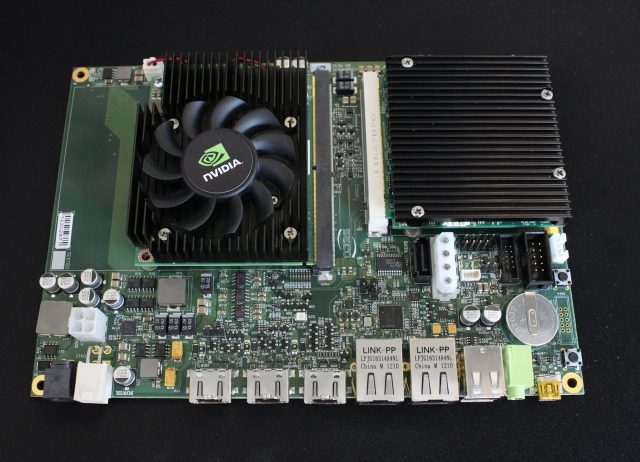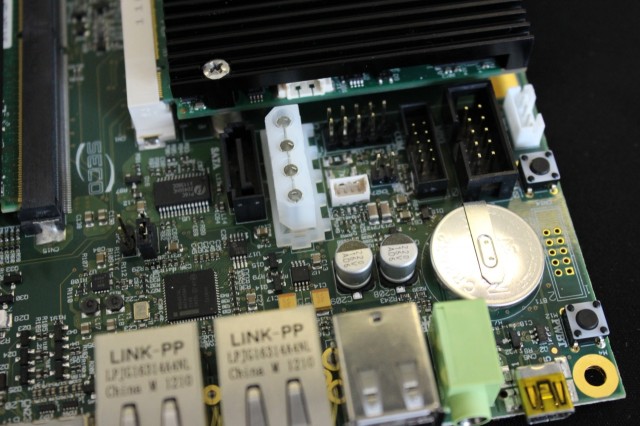
The "Kayla" motherboard is a way for software developers to begin porting their CUDA apps to the ARM architecture before it goes mainstream in 2014.
SAN JOSE, CA—Tegra 4 phones and tablets aren't quite here yet, but Nvidia is already giving us details about its successor, a chip codenamed "Logan." Due in early 2014, the new processor's primary innovation is that it brings the graphics architecture in Nvidia's mobile processors more or less up to date with the architecture in its GeForce and Quadro graphics products.
This updated GPU will obviously bring performance increases relative to present-day chips, but more important will be the level of API support that it makes possible in mobile devices. Anything supported by current Kepler-based graphics cards—including OpenGL 4.3, Direct3D 11, CUDA, OpenCL, and PhysX—will be possible in phones and tablets, albeit with less raw horsepower behind it than a high-end PC graphics card can provide.
To give developers a chance to start playing with these APIs, many of which aren't yet mainstream in ARM devices, Nvidia (with an Italian company named Seco) is showing off a new small form-factor motherboard called "Kayla" that's meant to provide roughly the same software features as Logan about a year before Logan is actually scheduled to come to market. We got a chance to take a look at the board here at Nvidia's GPU Technology Conference this week.
Tech specs

Kayla includes a fairly extensive list of ports and interfaces. The heatsink and fan on the left cools the Kepler GPU, while the passive heatsink on the right cools the Tegra 3 CPU.
Kayla combines three different components: a Seco motherboard, which offers three HDMI ports, one 100 megabit Ethernet port, one gigabit Ethernet port, two USB 2.0 ports, a headphone jack, a micro-USB port, a microSD card reader, and a SATA connector; a Seco daughterboard with a 1.3GHz Tegra 3 processor and 2GB of RAM; and an MXM daughterboard from Nvidia based on the Kepler architecture, which includes a GPU and 1GB of graphics RAM. Technically speaking, any card based on the MXM standard could be used with this board, though the MXM standard is rarely used outside of expensive, bulky gaming laptops, and cards can be difficult to come by.
The GPU itself, which will be available in May, is a Kepler-based GPU with 384 of Nvidia's CUDA cores. This exact GPU isn't quite the same as any of the company's currently shipping products. At least in core count, it's similar to some low-end and mid-range cards in the GeForce 600 series, most notably the GeForce 640 and 650 cards. Obviously, performance will vary based on clock speeds, memory speed and interface, and the number of PCI Express lanes available (the Seco daughterboard appears to offer four lanes, where most full-fledged PCs offer sixteen)—the power requirements of an ARM chip are going to keep Logan from running as quickly as today's low-end desktop graphics cards, but the raw processing power is there.
On the graphics side, at least, this board will give developers a good idea of what the next-generation of Tegra chips will be like with respect to supported APIs and performance level.
"With CUDA 5 and OpenGL 4.3, this is a preview of Logan," Nvidia General Manager of GPU Computing Ian Buck told Ars. "It provides the same programming model, features, and approximate performance of Logan."
In other words, for developers who want to bring their CUDA or PhysX-enabled workstation apps or games over to the ARM architecture, the Kayla board is the testing environment for you. Both in the exhibition hall and during CEO Jen-Hsun Huang's opening-day keynote, the board was shown running an ARM build of Ubuntu 12.04 as well as some Nvidia graphics demos—ray-tracing, smoke, and water simulations all appeared to be running with a reasonable degree of smoothness (as you can see in the official Nvidia video below).
While Nvidia's CUDA technology hasn't been available to developers on ARM before, this is the first step in that direction, and Nvidia will continue to improve support with future hardware and software. "Our next version of CUDA will support ARM first-class," Buck said.
Of course, while the Kayla board approximates the features and performance of Logan on the GPU side, the CPU side is pretty far-removed from what that product will be capable of. The Tegra 3 chip runs four 1.3GHz Cortex-A9 CPU cores, which is a far cry from even the 1.9GHz Cortex-A15 CPU cores that Nvidia has been showing off in its reference tablets for Tegra 4. We don't yet know much about Logan's CPU, but it stands to reason that it will be even faster than Tegra 4, putting quite a bit of distance between it and the Tegra 3 chip in Kayla. Nvidia told us that the decision to use Tegra 3 for this board rather than Tegra 4 came down to interface support—Tegra 3 supports the SATA interface and a PCI Express connection to an external GPU, and Tegra 4 does not.

Support for SATA is one reason why Kayla uses a Tegra 3 CPU rather than the newer, faster Tegra 4.
There's also no way that Kayla will fit in anything approaching the size of a modern tablet—it provides many of Logan's features, but it obviously lacks Logan's integration. “What’s amazing is that Logan will be the size of a dime, whereas Kayla is now the size of a tablet PC,” Jen-Hsun Huang said during Tuesday's keynote.
What’s next?

Kayla-esque boards paired with Tegra 3 CPUs and Nvidia GPUs are already being used to power high-density servers.
"A lot of people are interested in ARM for high-performance computing and next-generation supercomputers," Buck told Ars, "but they don't really have a development platform to port their code or experiment with their code on ARM. One of the reasons why we're doing this and bringing all the CUDA stuff to there is to help that software ecosystem get jumpstarted on ARM."
Some of Nvidia's competitors are also looking into this space, which would theoretically replace the (relatively) few powerful x86 CPUs in today's servers and supercomputers with many slower but more power-efficient ARM processors. AMD has announced its intention to enter into this market in 2014 with its own ARM chips, and Intel is fighting back by using its Atom processors to do the same thing without the switch in processor architectures.
While Buck told us that Nvidia's focus with Tegra was to stay focused on the consumer market—that is, smartphones and tablets and related devices like the Shield gaming tablet—he didn't rule out the use of Nvidia's ARM chips in future servers. In particular, the follow-up to Logan (codenamed Parker) will support 64-bit ARM instructions, making it better-suited for memory-intensive server applications than current Tegra chips.
There's nothing stopping Nvidia's partners from using Kayla (and other, similar products) in products like this now, though. A company called E4 already uses Kayla-esque motherboards, Tegra 3 CPUs, and Quadro GPUs in its ARKA Microcluster, which Seco was showing off in the exhibition hall. These servers can cram 24 CPUs and 24 GPUs into a server that consumes about 1200 watts of power, a relative pittance if you have a workload that needs to be able to execute many smaller tasks rather than a few large ones. Products like these are something we'll only see more of as ARM chips (and their accompanying GPUs) become more capable.
No comments:
Post a Comment
Let us know your Thoughts and ideas!
Your comment will be deleted if you
Spam , Adv. Or use of bad language!
Try not to! And thank for visiting and for the comment
Keep visiting and spread and share our post !!
Sharing is a kind way of caring!! Thanks again!